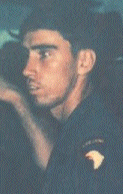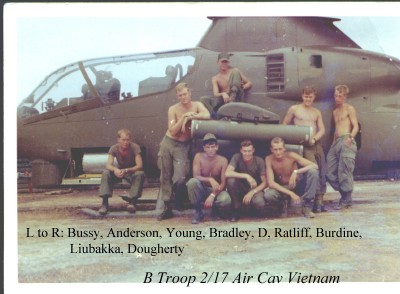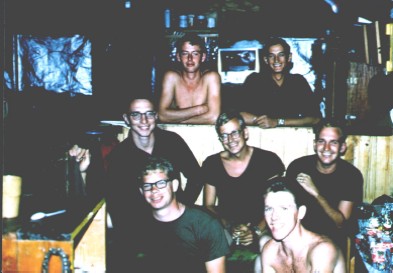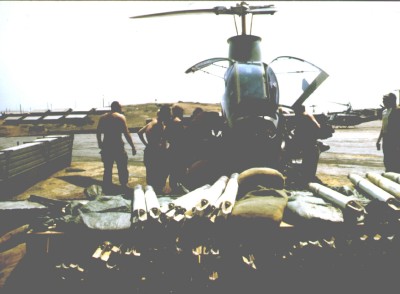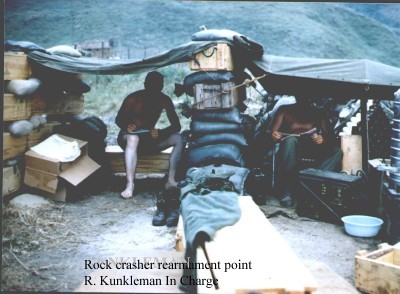NOTE: This article is a condensed version of several sources and viewpoints that may conflict with other sources. For a complete factual account of operation "Lamar Plain", please refer to "After Action Report on Operation Lamar Plain" filed 15 Sept 1969, by Col. Frank L. Deitrich, the commanding officer of the 1st Brigade of the 101st Airborne Division (AMBL) |

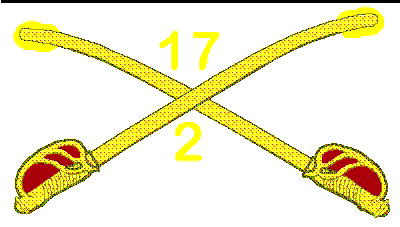
|
The Americal Division had only one air cavalry troop (F Troop, 8th Cavalry “Blueghost”) and very limited gunship support. The 2nd NVA Regiment was unaccustomed to the tactics and sheer numbers of helicopters it would face in the days to come. By the second day of the mission, the full weight of the 101st’s air cav, the aerial rocket artillery and close air support was being brought to bear on the NVA. On the third day the brigade aeroscouts found what they had been looking for. A scout pilot had noticed a series of dark spots on the ground in a low area dominated by several small hills. When the pilot began working the area, he encountered a large volume of fire from the surrounding hills, and the accompanying ARA gunships made strike after strike. The enemy here was now more disciplined and much heavier than the scouts had experienced in the previous two days. When the birds ran low on fuel and munitions, a FAC arrived with F-4s (Phantom fighter-bombers) to continue the fight. The cycle was repeated several times, alternating Cobras and F-4s, until the enemy action had ceased. At that point the scouts were able to examine the target area closely. Each dark spot marked a fallen American soldier, the dark spots around each body caused by blood that had soaked the ground and turned dark as it dried. And each body had several bamboo poles thrust into it at odd angles. The scouts had found the wounded who had been left behind, and there were no survivors. Looking for an elusive, shy enemy. The NVA had come to fight, and they had brought their lunch. Their .51s were well -positioned, supporting each other and commanding the high ground. Every airstrike, every resupply, every medevac was contested by interlocking .51 caliber anti-aircraft fire. As many as seven guns would engage a single aerial target, and each of these positions was supported by dozens of 7.62mm automatic weapons. Although their makeup was different, the size of the two opposing forces was similar enough that neither side could maneuver for a decisive advantage. For every company-sized flanking movement performed by one opponent, a successful countermove was devised by the other. For several days this deadly fandango continued without letup. The helicopter crews as well as the infantry were beginning to feel the pressure of sustained combat. By the end of the first week of the battle, only one OH-6 and two Cobras were flyable. Of all the aircraft of an air cav troop, an ARA battery and a scout sec-tion, all but three were shot down or were so badly damaged that they could not fly for a 24-hour period. It was rumored that the “groundpounders” had lost 75 killed in action, and it was easy for those who were there to believe it. The main problem was the .51s. Their fire was devastating to unarmored troops and thin-skinned aircraft. Their heavy staccato hammering made all other battlefield noise seem like whispers. A team of .51s (two, three, four, even more) and supporting small arms would stop an infantry advance cold. The initial helicopter losses were a result of poor tactics. Pink teams and unprotected white teams were simply outgunned by the anti-aircraft the enemy had deployed in and around Death Valley. Recon flights that normally required a team of two helicopters now were performed by a team of five or six aircraft. After the tactics were changed (by the middle of the second week), helicopter losses dropped significantly. The air cav operated in heavy teams of two or three Cobras covering the scouts, with a Huey high overhead to act as a recovery bird if someone was shot down. The brigade aeroscout teams were even heavier; each mission consisted of two LOHs low, two ARA Cobras, a FAC and two F-4s on station. There was no more hovering or following footprints for the scouts. From 3,000 feet, the LOHs would dive for the jungle as fast as possible. This would put them in the “dead man’s zone” for the least amount of time. (From a distance of 50 to 1,500 feet, automatic weapons were very effective against helicopters; when the LOHs were operating against .51s, the danger zone was increased to 3,000 feet.) The LOHs would keep their speed up as they made a run over a target area. Inevitably they would draw heavy fire from dozens of AK-47s and as many as six or seven .51s. The gunners and observers would drop as many white phosphorus grenades as possible to mark the targets, while trying to simultaneously suppress the enemy with M-16, M-60 and minigun fire. After a marking run by the scouts, the Cobras would roll in with rockets and 40mm grenades. Usually the Cobras would expend their ammunition and the enemy positions would be pounded by artillery. Although the U.S. and NVA forces were numerically somewhat similar, the fire support and logistical backup afforded the American forces made for a vast difference between the 1st Brigade and the 2nd NVA Regiment. By the third week of the battle, the 2nd Regiment began trying to break contact, in an effort to fade away into the jungle. The regiment had broken up into company and platoon-sized elements and dispersed. The primary goal of the U.S. air cav and aeroscout units at that point was to find these elements so the infantry could finish their destruction. There were reports of a complete NVA hospital to the south of the A/O, and it was thought that the remnants of the 2nd Regiment would try to evade in that direction or to the west, toward Laos. For days scout teams and patrols scoured the hills north, south and west of Death Valley. Although there was frequent contact with the enemy, the NVA troops encountered were generally isolated stragglers or small, disorganized units. Had the 2nd Regiment successfully evaded the 1st Brigade, either linking up with the hospital to the south or, more likely, reaching Laos in the west? To most of the brass, it seemed likely. But a small group at brigade S-2 (Intelligence) was not convinced that such a large unit, though substantially reduced in number, could evade such a comprehensive net as the 101st had laid within the A/O. And the Americal Division, operating around the 101st, had not detected the 2nd Regiment outside the A/O, south or west. Only one alternative remained: the 2nd Regiment was still in the A/O. With pressure mounting from blocking forces to the north, south and west, they had to go east. But to the east lay the open coastal plain and Route 1. Any large-scale movement there would immediately be detected and easily destroyed. Only one possibility remained. There was a small mountain just west of Tam Ky that defined the easternmost boundary of the 101st A/O and Death Valley. It was possible that the enemy force had evaded unexpectedly to the east, toward the strength of the U.S. forces, and was hiding practically under the Americans’ noses. The theory did not get much support from the command. No ground forces would be available to search the area, but the aeroscouts were authorized to begin systematically exploring the large hill mass named Recon Zone Alpha. Alpha had been left alone until now; none of the 101st units had looked very closely at it, even though every helicopter that had operated within the A/O had to fly by it on its way in or out. It was the dominant piece of terrain in the whole sector; in retrospect, that no U.S. units were located on it is surprising. Beginning in late May 1969, the aero-scouts worked Recon Zone Alpha daily. The hill mass was covered with low jungle broken occasionally by cultivated fields and grass hooches. It was obvious that the fields were being worked daily, even though all friendly personnel had evacuated when operations began in May. With the 2nd Regiment surrounded and friendlies removed, U.S. forces began a scorched-earth policy to deny food and shelter to the enemy. All structures in Recon Zone Alpha were to be destroyed, the crops were to be burned, and all livestock was to be slaughtered. Cobras made gun runs on chickens and water buffalo (by the time the scout teams returned from rearming and refueling, the buffalo would be butchered and carted off.) The scouts burned dozens of hooches and many revealed bunkers concealed within them. The top of Recon Zone Alpha seemed to be covered with concealed fighting positions, but no one would shoot at the little helicopters. And so far, no enemy had been seen. Until the scout teams could report significant enemy contact, the chain of command would not believe that the hill mass was worth more than the efforts of the aeroscouts. Almost a week went by, with the infantry patrolling Death Valley, the air cav screening west, north and south, and the brigade scouts patrolling Recon Zone Alpha. Little was accomplished except the discovery of enemy bunker complexes, caches of weapons and buried bodies. It seemed that Operation Nathan Hale was winding down of its own volition. The frustration of the brigade scouts and their S-2 observers was reaching critical mass when help arrived from an unexpected quarter. A holiday cease-fire was called in the last week in May - it sometimes seemed as if Buddha had a birthday every other month. Instructions were for no one to engage a target except in self-defense. The aeroscouts once again lifted off for Recon Zone Alpha, expecting another frustrating outing. The white team had not been in the area very long when the lead LOH reported very excitedly that he had “gooks in the open, NVA everywhere!” The team leader in the trail ship asked what they were doing and how they knew the soldiers were NVA. The lead pilot reported that they were just sitting around, lounging in the shade. He knew they were NVA because he could see the stars on their belt buckles! He had no idea how many were down there; they were everywhere. Some were waving at him, and one shot him the finger! What followed is a bit hazy. One pilot said he asked if anyone had taken fire. The other pilot thought someone yelled “Taking fire!” At any rate, the door gunner opened fire, inflicting several casualties. The trail scout, hearing the M-60 fire, began suppressing fire with his minigun. Soon the sky was full of tracers, red and green. So much for a cease-fire. The white team, having no Cobra cover, decided to return to Chu Lai to coordinate support. The aeroscouts returned with a pair of ARA Cobras. They had kicked over a hornet’s nest; the team began taking fire several kilometers out, while still at high altitude. As had happened just a month previously, they took fire no matter which way they turned. The scouts kept their speed up and threw grenades as fast as they could. As the Cobras expended their munitions, another team was scrambled from Chu Lai, and tube artillery was called in. There was no doubt in the scouts’ minds that what was left of the 2nd Regiment had just showed their hand. The higher-ups still were not convinced that this was the main body of the enemy regiment. They were sure that the aeroscouts had found a few stragglers, or maybe a local VC platoon. S-2 wanted to insert an infantry company to develop the situation, and it was decided a platoon would do just as well. Early the next day, the blues (aerorifles) from B troop, 2/17 Air Cav, under the command of First Lieutenant Charles M. Burke (Mike*) were inserted in a clearing on the very summit of Recon Zone Alpha. 1LT Fernando "Sugg" De Pierris and CWO Terry Fields led a flight of five Hueys. It all had the makings of a routine combat assault. They took off to the west, as they had done almost every day since arrival, leaving behind the blue waters of the South China sea, just accross from Route 1. "Doc" LaPoint, the unit's medic, was seating in his usual place, on the far right of the five place seat, sideways, his feet dangling, his medical supplies firmly against his chest. The rest of the blues sat everywhere in the chopper, as usual. They headed west, climbed at altitude, the heat of the helicopter now dissipated by the rotor wash and altitude, and the loose trail formation made a wide left turn, heading for the touch down point atop Recon Zone Alpha. As their made their approach the gunships followed them on the left flank, firing rockets, grenades, and miniguns. They pass after pass to protect the combat assault. CWO Ken Barwick led the gunships in their gun runs. 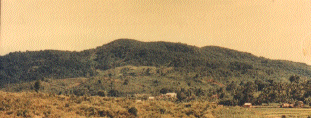  By the time the last UH-1 had departed, several troopers had been wounded and killed. Lt Burke radioed the Troop Commander: “Six, we have 3 KIA’s”. 
“They are ours” replied Lt Burke… and there was dead silence. The unit had never experienced this sort of engagement, so quickly. The pilots and crews could only wonder who the KIA’s were, they all had friends in the aerorifle platoon, their dear “Blues” KIA's names were not to be mentioned on the air. There was wondering and anxiety: sadness and disbelief. The blues were pinned down and there was not much the pilots and crews could do. The blues took cover and returned the fire as best as they could. Sgt Sanders died while talking on the radio. Doc LaPoint took care of the wounded, crawling from one to the other, in spite of being severely wounded. Running of out of ammo, Lt Burke called for more and an ammo resupply was ordered. Lt De Pierris took the mission and asked for a volunteer crew. A young warrant officer, Steve Keeler volunteered as co-pilot. 3 young men volunteer as door gunners and to unload the ammo. Their names are forgotten but their actions never will. The mission was pretty much a suicide mission. Supported by heavy fire from the gunships, HU1-H 69761 returned to the LZ atop Recon Zone Alpha. The expected fire never materialized and the ammo drop turned out to be a routine affair. Perhaps the NVA had held their fires to avoid giving away their positions, we will never know. Next it was decided to commit the entire infantry company, right on top of the mauled platoon. The LZ was small, surrounded by jungle shrub and low trees. The company was inserted piecemeal and it, too, took heavy casualties. Brigade scouts covering the combat assault con-firmed that the U.S. troops on the ground were surrounded, and reported .51 fire. Efforts by the infantry company to fight its way out of the LZ were fruitless. It was soon apparent that the unit had been inserted right in the middle of what was left of the 2nd Regiment. Although they had been routed after a month of heavy fighting, the regiment was still organized and well-disciplined, and perhaps battalion strength. The Americans on that LZ spent a night they would never forget. The blues were now OPCON to Brigade and the aerorifles, their ships empty, headed back home to Chu Lai. There was nothing for them to do, there was nothing they could do. Flying south along the coast, the call was heard on the radio:
"SHIT!" was all that Terry Fields could say. The clubs of MAG13 did not have the usual clientele from B Troop
that night. With their comrades pinned down, spending the night on RZ Alpha, going to
the club was the last thing on their minds. While the action was going on atop the hill, an assortment of 101st, Americal and ARVN (Army of the Republic of Viet-nam) units were being assembled to set up blocking positions around the base of Recon Zone Alpha. The U.S. assaults began to gain momentum; ground was gained in all directions from the original LZ. The 2nd Regiment was fighting for its life and losing. As position after position was overrun by the GIs, equipment peculiar to a headquarters was being found - stacks of new uniforms, sewing machines, medical supplies (many from the United States). Finally, as the fighting began to taper off, the North Viet-namese regimental commander and a few of his staff were found dead in a fighting position. The 2nd Regiment had ceased to exist. NVA prisoners later referred to this operation as “the big fight with the little helicopters.” They were surprised at the aggressiveness the scouts exhibited and the firepower at their command. It is not much of a name for a battle, and unlike Tet, Hamburger Hill and Khe San, it will never be found in his-tory books. But every soldier who came out of Death Valley and Recon Zone Alpha knew he had been in one helluva fight. For a view of the 2 June 1969 entry in the Brigade's After Action Report click here... |
|
|
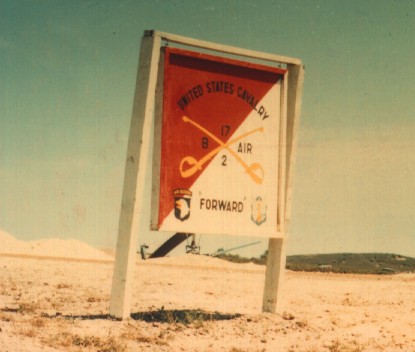 Tent
City at
Tent
City at  Chu Lai. The next morning the rest of the battalion began its
insertion into the LZ, right on top of everyone else, a platoon at a time.
The LZ was too small to accept more than three or four choppers simultaneously.
As each platoon landed, it immediately entered the fight to enlarge the
perimeter. The pressure on the perimeter was maintained all day by the
aeroscouts, ARA, and gunships, with a team on station almost constantly.
Finally, after three days, three companies had formed around the perimeter
of the LZ and began making progress toward breaking out. The fighting was
so close most of the time that TAC Air could not be used. The LOHs were
called on several times to act as point for an infantry column, blasting
through ambushes with miniguns and grenades. One LOH crew was awarded Silver
Stars for hovering over two wounded GIs, covering them from NVA only 15
meters away, until their comrades could use ropes to pull out to safety,
out of the line of fire.>/P>
Chu Lai. The next morning the rest of the battalion began its
insertion into the LZ, right on top of everyone else, a platoon at a time.
The LZ was too small to accept more than three or four choppers simultaneously.
As each platoon landed, it immediately entered the fight to enlarge the
perimeter. The pressure on the perimeter was maintained all day by the
aeroscouts, ARA, and gunships, with a team on station almost constantly.
Finally, after three days, three companies had formed around the perimeter
of the LZ and began making progress toward breaking out. The fighting was
so close most of the time that TAC Air could not be used. The LOHs were
called on several times to act as point for an infantry column, blasting
through ambushes with miniguns and grenades. One LOH crew was awarded Silver
Stars for hovering over two wounded GIs, covering them from NVA only 15
meters away, until their comrades could use ropes to pull out to safety,
out of the line of fire.>/P>
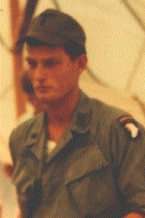
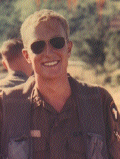
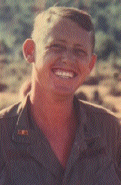
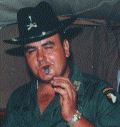 1L
Fernando De Pierris Slicks
1L
Fernando De Pierris Slicks 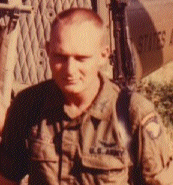 Capt
Livingston Scouts
Capt
Livingston Scouts 

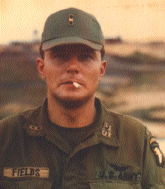 CWO
Terry Fields Slicks
CWO
Terry Fields Slicks  CWO
Bob Mullins Scouts
CWO
Bob Mullins Scouts 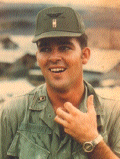



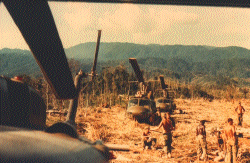 The
Crews at
The
Crews at What's
a little damage?
What's
a little damage? 